Liability of Partnership and False Advertisement: Legal Analysis
9 Pages1941 Words237 Views
Added on 2023-06-09
About This Document
This article discusses the liability of partnership and false advertisement under Australian law. It analyzes relevant cases and principles such as promissory estoppel. The article covers topics such as the Partnership Act 1892, section 29 of the Australian Consumer Law, and the principle of unconscionable conduct. It also provides a case study for each topic to illustrate its application.
Liability of Partnership and False Advertisement: Legal Analysis
Added on 2023-06-09
ShareRelated Documents
End of preview
Want to access all the pages? Upload your documents or become a member.
LAW 6000 – Business and Corporate Law
|7
|1929
|82
Business Law Case Studies and Legal Principles
|7
|1956
|443
Business Law Assignment: Liability of Partnership, Legal Remedies, Unconscionable Conduct, and Promissory Estoppel
|8
|1945
|127
Business and Corporate Law
|9
|1954
|188
Business and Corporate Law
|8
|1856
|428
Legal Issues and Remedies in Partnership, False Advertising, and Promissory Estoppel
|9
|1898
|268



